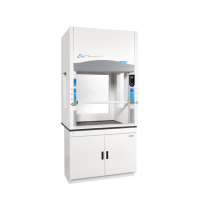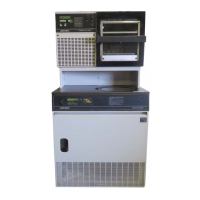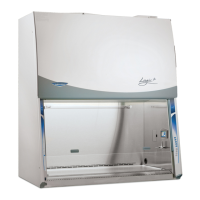Chapter 3: Getting Started
Product Service 1-800-522-7658
Electrical Connection
Plug the power cord into the receptacle on the back of the CentriVap Cold Trap
and plug the other end into a suitable power receptacle. Plug the power cord from
the vacuum pump into a suitable receptacle.
Ground Wire
CAUTION: Solvents may be flammable. When draining the CentriVap Cold
Trap always attach the other end of the grounding clip to the solvent catch
pot to eliminate the risk of electrostatic spark ignition.
Attach one end of the included ground wire to the stainless steel elbow on the
drain tubing on the right or left side (depending on model) of the Cold Trap.
Chemical Resistance of CentriVap Cold Trap
Components
Your CentriVap Cold Trap is designed to be chemically resistant. However, by
necessity, the Cold Trap is comprised of a number of different materials, some of
which may be attacked and degraded by corrosive chemicals. The degree of
degradation is obviously dependent on the concentration and duration of
exposure. Some major components of the Cold Trap that are susceptible to
degradation are as follows:
If a rotary vane vacuum pump is used, frequent oil changes are required.
Many compounds will degrade the oil if allowed to enter to pump.
Diaphragm vacuum pumps sold by Labconco have wetted parts either made
from PTFE or protected by PTFE coatings and are suitable for nearly all
procedures.
Trifluoroacetic Acid (TFA)
Dimethyl Sulfoxide (DMSO)
Methyl t-Butyl Ether (MTBE)
Lid Acrylic C D C D D D D C D D C D D
Bearings High Carbon Steel D D D D D D D D D D D
Lid Gasket EPDM D D D D D C C D
Rotor Shaft Stainless Steel D D D
Valve Stainless Steel D D D
O Rings Viton (Fluorocarbon) C C C D C
Fittings Polypropylene D C
Rotor Anodized Aluminum D D
Rotor Hub Acetal (Delrin) C C C D D D C D C
Tubing PVC D C D D D D D D D C D D D D
Chamber Teflon coated Aluminum
Bearings Stainless Steel D D D
Lid Gasket EPDM D D D D D C C D
O Rings Viton (Fluorocarbon) C C C D C
Fittings Polypropylene D C
Rotor Teflon coated Aluminum
Rotor Hub Polypropylene D C
Tubing PVC D C D D D D D D D C D D D D
Chamber Stainless Steel D D D
Lid Acrylic C D C D D D D C D D C D D
Cold Trap Gasket Neoprene D D C D D C D D D D D C D
Chamber Stainless Steel D D D
Lid Stainless Steel D D D
Cold Trap Gasket Neoprene D D C D D C D D D D D C D
C- Moderate Degradation- Questionable use
D- Severe Degradation- Infrequent use recommended- immediate thorough cleaning required
Trifluoroacetic Acid (TFA)
Dimethyl Sulfoxide (DMSO)
Methyl t-Butyl Ether (MTBE)
Lid Acrylic C D C D D D D C D D C D D
Bearings High Carbon Steel D D D D D D D D D D D
Lid Gasket EPDM D D D D D C C D
Rotor Shaft Stainless Steel D D D
Valve Stainless Steel D D D
O Rings Viton (Fluorocarbon) C C C D C
Fittings Polypropylene D C
Rotor Anodized Aluminum D D
Rotor Hub Acetal (Delrin) C C C D D D C D C
Tubing PVC D C D D D D D D D C D D D D
Chamber Teflon coated Aluminum
Bearings Stainless Steel D D D
Lid Gasket EPDM D D D D D C C D
O Rings Viton (Fluorocarbon) C C C D C
Fittings Polypropylene D C
Rotor Teflon coated Aluminum
Rotor Hub Polypropylene D C
Tubing PVC D C D D D D D D D C D D D D
Chamber Stainless Steel D D D
Lid Acrylic C D C D D D D C D D C D D
Cold Trap Gasket Neoprene D D C D D C D D D D D C D
Chamber Stainless Steel D D D
Lid Stainless Steel D D D
Cold Trap Gasket Neoprene D D C D D C D D D D D C D
C- Moderate Degradation- Questionable use
D- Severe Degradation- Infrequent use recommended- immediate thorough cleaning required

